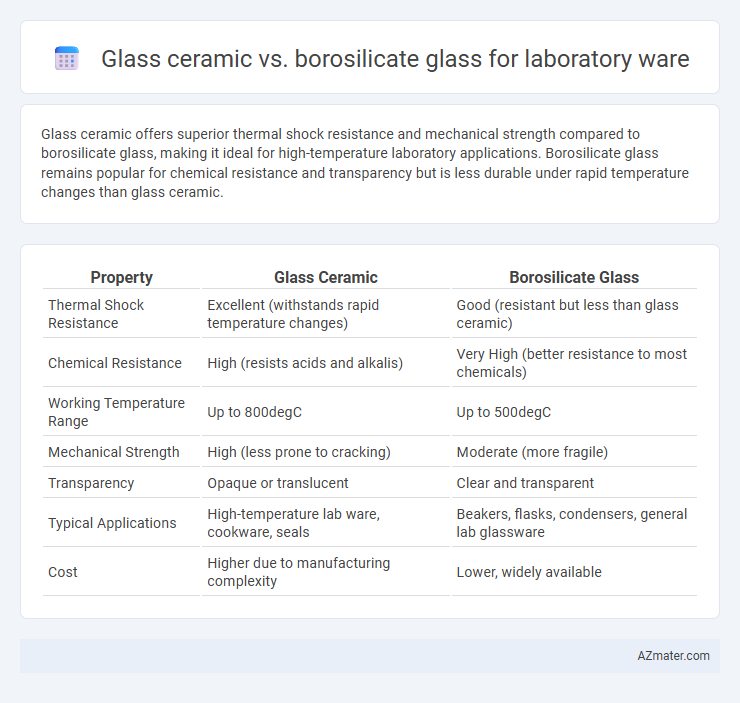Glass ceramic offers superior thermal shock resistance and mechanical strength compared to borosilicate glass, making it ideal for high-temperature laboratory applications. Borosilicate glass remains popular for chemical resistance and transparency but is less durable under rapid temperature changes than glass ceramic.
Table of Comparison
| Property | Glass Ceramic | Borosilicate Glass |
|---|---|---|
| Thermal Shock Resistance | Excellent (withstands rapid temperature changes) | Good (resistant but less than glass ceramic) |
| Chemical Resistance | High (resists acids and alkalis) | Very High (better resistance to most chemicals) |
| Working Temperature Range | Up to 800degC | Up to 500degC |
| Mechanical Strength | High (less prone to cracking) | Moderate (more fragile) |
| Transparency | Opaque or translucent | Clear and transparent |
| Typical Applications | High-temperature lab ware, cookware, seals | Beakers, flasks, condensers, general lab glassware |
| Cost | Higher due to manufacturing complexity | Lower, widely available |
Introduction to Laboratory Glassware Materials
Glass ceramics and borosilicate glass serve as fundamental materials in laboratory glassware, each offering distinct thermal and chemical properties essential for experimental accuracy. Glass ceramics provide superior mechanical strength and thermal stability due to their crystalline microstructure, making them ideal for high-temperature applications and resistance to thermal shock. Borosilicate glass, composed primarily of silica and boron oxide, is prized for its excellent chemical durability and low thermal expansion coefficient, ensuring precise thermal resistance and minimizing risk of breakage during rapid temperature changes.
What is Glass Ceramic?
Glass ceramic is a type of laboratory ware material characterized by its unique microstructure, combining glass and crystalline phases for enhanced thermal shock resistance and mechanical strength. Unlike borosilicate glass, which primarily offers chemical durability and thermal resistance, glass ceramics withstand rapid temperature changes without cracking, making them ideal for high-temperature laboratory applications. The inherent stability of glass ceramic materials minimizes thermal expansion, providing superior performance in environments requiring frequent heating and cooling cycles.
What is Borosilicate Glass?
Borosilicate glass is a type of laboratory glassware known for its exceptional thermal resistance and chemical durability, composed primarily of silica and boron trioxide. Its low coefficient of thermal expansion makes it ideal for applications involving rapid temperature changes, ensuring minimal stress and high resistance to cracking. Compared to glass ceramic, borosilicate glass is more transparent and widely used in lab environments for precise chemical analysis and heat-related experiments.
Thermal Resistance: Glass Ceramic vs Borosilicate Glass
Glass ceramic exhibits superior thermal resistance compared to borosilicate glass, withstanding rapid temperature changes up to 1000degC without cracking due to its low thermal expansion coefficient (close to zero). Borosilicate glass, widely used in laboratory ware, tolerates thermal shock up to approximately 450degC, benefiting from its moderate thermal expansion but remaining less resistant in extreme fluctuations. This makes glass ceramic ideal for high-temperature applications requiring exceptional thermal stability, whereas borosilicate glass suits general lab tasks with moderate heat exposure.
Chemical Durability Comparison
Glass ceramic exhibits superior chemical durability compared to borosilicate glass due to its crystalline structure, which resists chemical attack from acids, bases, and solvents more effectively. Borosilicate glass, although resistant to thermal shock and many chemicals, is more prone to surface degradation and leaching under prolonged exposure to aggressive reagents. In laboratory environments requiring long-term chemical resistance, glass ceramics reduce contamination risks and maintain structural integrity better than borosilicate glass.
Mechanical Strength and Durability
Glass ceramic offers superior mechanical strength and thermal shock resistance compared to borosilicate glass, making it highly durable under extreme laboratory conditions. Borosilicate glass provides good chemical resistance and moderate mechanical robustness but is more prone to cracking under rapid temperature changes. For applications requiring enhanced durability and resistance to mechanical stress, glass ceramic is the preferred choice in laboratory ware.
Transparency and Optical Properties
Glass ceramic laboratory ware offers superior thermal shock resistance but typically exhibits lower transparency compared to borosilicate glass, which is renowned for its high optical clarity and excellent light transmission. Borosilicate glass provides consistent refractive index and minimal light distortion, making it ideal for precise optical measurements and visual observations in laboratory settings. The transparency and optical properties of borosilicate glass enhance visibility and accuracy, whereas glass ceramics combine durability with moderate translucency but sacrifice clarity.
Cost and Availability
Glass ceramic laboratory ware generally costs more than borosilicate glass due to its advanced thermal shock resistance and durability, making it a premium choice for high-stress applications. Borosilicate glass is widely available and more affordable, favored for routine lab use because of its chemical resistance and moderate heat tolerance. Laboratories often select borosilicate glass when budget constraints and accessibility are key factors, while glass ceramic is reserved for specialized environments demanding superior performance.
Common Applications in Laboratories
Glass ceramic laboratory ware excels in high-temperature applications such as crucibles, furnace windows, and thermal shock-resistant containers due to its exceptional thermal stability and low thermal expansion. Borosilicate glass is widely used for general-purpose labware including beakers, flasks, and test tubes, valued for its chemical resistance and ability to withstand moderate thermal stress. Both materials are essential in laboratory environments, with borosilicate favored for routine chemical handling and glass ceramics preferred in high-heat or rapid temperature change scenarios.
Choosing the Right Material for Your Laboratory Needs
Glass ceramic offers superior thermal shock resistance and mechanical strength compared to borosilicate glass, making it ideal for high-temperature applications and heavy-duty laboratory use. Borosilicate glass excels in chemical durability and transparency, providing clear visibility and resistance to most acids and alkalis, suitable for routine chemical experiments. Selecting the appropriate material depends on the specific laboratory conditions, such as exposure to rapid temperature changes or the need for chemical resistance, ensuring safety and performance in experimental setups.

Infographic: Glass ceramic vs Borosilicate glass for Laboratory ware
 azmater.com
azmater.com